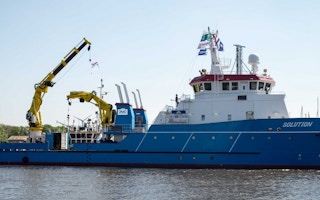Surveys of the seafloor will begin this year for a ground-breaking project to export solar electricity from Australia’s Northern Territory to Singapore via a 3,800km submarine power cable.
To continue reading, subscribe to Eco‑Business.
There's something for everyone. We offer a range of subscription plans.
- Access our stories and receive our Insights Weekly newsletter with the free EB Member plan.
- Unlock unlimited access to our content and archive with EB Circle.
- Publish your content with EB Premium.
Sun Cable, the project developer, has awarded the cable route survey contract to Australian firm Guardian Geomatics, which will use its sister company’s vessel to conduct its work.
The survey will provide data on properties of the rock on the seafloor as well as information on the water column, such as current, salinity and temperature, said Sun Cable director Fraser Thompson. The data will support a detailed route analysis and cable design for the project.
The survey is dominated by sensing processes and will have low environmental impact, he said. It will take several months to complete.
According to a report by the United Nations Environment Programme World Conservation Monitoring Centre and the non-profit International Cable Protection Committee, cable route surveys rely primarily on acoustics-based echosounding, sonar and seismic systems. These focus on the seabed surface and, where burial is concerned, the few metres of sediment below the seabed, stated the 2009 report, Submarine cables and the oceans: Connecting the world.
While there is incomplete knowledge of the responses of marine animals to different sources of noise, cable survey equipment is regarded as posing only a “minor risk” to the environment compared to prolonged high-energy mid range sonar systems, which may be associated with strandings of some whale species and are the subject of ongoing research, the report stated.
On the environmental impact assessments and safeguards that Sun Cable plans to put in place for the A$20 billion project, Thompson said: “Sun Cable is developing the project in strict compliance with the various regulations applicable to the project. Environmental approvals will be progressively sought as the project design becomes more advanced and the relevant environmental studies are completed.”
While clean energy is essential to fight climate change, there is growing awareness that projects must not harm valuable wildlife habitats.
Sun Cable’s project—dubbed the Australia-Asean Power Link—generated much excitement when it was announced last year. Besides having the world’s largest solar farm spanning 12,000 hectares in the Northern Territory, the 10 gigawatt-peak project will have battery storage as well as the world’s longest subsea cable connection by far.
The solar farm will supply electricity to Darwin through overhead transmission lines, and transmit two gigawatts to Singapore through high-voltage direct current cables, which is equivalent to powering 350,000 households in the city-state for a year.
If achieved, it would allow Singapore to break its heavy dependence on natural gas for electricity and help reduce its carbon emissions beyond 2030, which is when its government has said emissions would peak. After 2030, Singapore’s goal is to halve emissions by 2050 and work towards net zero in the second half of the century.
Sun Cable’s project would also boost renewables uptake in the Northern Territory and set an example for similar renewable energy exports in other parts of the world.
Experts have called the Australia-Asean Power Link a very ambitious endeavour that would take at least 10 years to implement.
In recent months, Sun Cable has raised tens of millions of dollars, including from Australian billionaires Andrew Forrest and Mike Cannon-Brookes, to undertake the development phase of the project. The company said less than A$50 million was raised so far.
Closer cooperation between Singapore and Australia
The project’s progress comes as Singapore and Australia look to cooperate more closely on low-emissions solutions.
After both countries’ prime ministers held a videoconference in March, Singapore and Australia said they would work together on “practical projects or initiatives in developing hydrogen markets, supply chains and standards; carbon capture, utilisation and storage (CCUS) and renewable electricity trade”. Both countries are set to conclude a memorandum of understanding this year.
Asked if Sun Cable has held discussions with Singapore’s Energy Market Authority and Australian regulators, Thompson said it is “engaged with various regulatory bodies on a number of matters”.
Another major renewable energy scheme that is making progress is the Asian Renewable Energy Hub, by a consortium made up of renewable energy hub developer InterContinental Energy, CWP Energy Asia, wind energy firm Vestas and private investment company Pathway Investments.
It was recommended for environmental approval earlier this month by Western Australia’s Environmental Protection Authority, subject to conditions including monitoring and managing impacts on migratory birds and consultation with stakeholders such as traditional land owners.
The project expects to generate up to 15 gigawatts of wind and solar energy in Western Australia, the bulk of which would be used to produce green hydrogen products for domestic and overseas markets. It also plans to export electricity to countries such as Indonesia and Singapore.
In an update of Singapore’s solar roadmap released last month, the Solar Energy Research Institute of Singapore and other partners found that solar capacity of 5 gigawatt-peak could meet up to 43 per cent of Singapore’s electricity demand at mid-day by 2050, up from about 5 per cent currently.
Researchers conducted an initial grid impact assessment and did not foresee “critical concerns” up until 2030. For 2050, however, Singapore would need to ensure grid resilience with greater solar deployment and intermittency in solar output caused by extreme weather events, such as sudden island-wide thunderstorms, they said.
“This would call for mitigation measures such as solar forecasting, flexible conventional generation, energy storage systems and demand-side management where necessary,” the report stated.

















